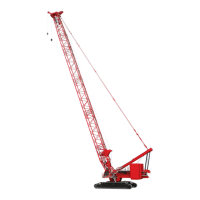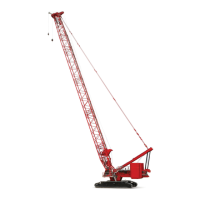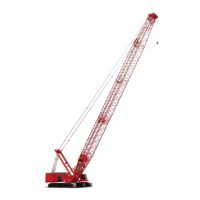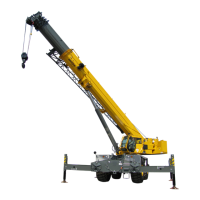Manitowoc Published 04-06-18, Control # 231-14 2-15
MLC650 VPC-MAX™ OPERATOR MANUAL SAFETY INFORMATION
SAFETY DEVICES
Manitowoc provides the following safety devices on its
cranes.
1. Horn activated by a switch on the control console in the
operator’s cab
If the horn is not working properly, it must be tagged-out
or removed if possible.
2. Crane level indicator: either electronic (viewable in
crane’s electronic display) or mechanical (viewable from
operator’s cab seat). If the crane level indicator is not
working properly, it must be tagged-out or removed, if
possible.
3. Cranes operating on a barge require: a trim indicator, a
swing brake, and a wind direction indicator if the wind is
a factor (supplied by crane owner or user).
4. Boom stops, both physical and automatic
If a boom stop is damaged or not working properly, it
must be tagged-out or removed if possible.
5. Jib stops, both physical and automatic (for fixed jib and
luffing jib)
If a jib stop is damaged or not working properly, it must
be tagged-out or removed if possible.
6. Pedal locks for all foot-operated brakes (if applicable)
If a pedal lock is damaged or not working properly, it
must be tagged-out or removed if possible.
7. An integral holding device or check valve on each
jacking cylinder
OPERATIONAL AIDS
Manitowoc provides the following operational aids on its
cranes, either as standard equipment or optional equipment.
The operational aids are designated as Category 1 or
Category 2:
Category 1 Operational Aids
If a Category 1 operational aid is not working properly, it
must be repaired no later than 7 calendar days after the
deficiency occurs.
Exception: If the crane user documents that he/she has
ordered the necessary parts within 7 calendar days of the
occurrence of the deficiency, the repair must be completed
within 7 calendar days of receiving the parts.
1. Boom or Luffing Jib Angle Limiter
(automatic boom or jib stop)
Temporary alternative measures if inoperative or
malfunctioning:
The qualified person directing the lift shall make sure the
maximum boom or jib angle/radius specified in the
Capacity Chart for the load being handled is not
exceeded. Use one or more of the following methods:
a. Measure radius using a tape measure.
b. Measure the boom angle with a protractor-level on
the centerline of boom.
c. Clearly mark the boom or luffing hoist cable (so it
can easily be seen by the operator) at a point that
gives the operator sufficient time to stop the boom
or jib within the minimum allowable radius.
In addition, install mirrors or remote video cameras
and displays if necessary for the operator to see the
mark.
d. Clearly mark the boom or luffing hoist cable (so it
can easily be seen by a designated signal person)
at a point that gives the signal person sufficient time
WARNING
Do not operate the crane unless all safety devices listed in
this section are in proper working order.
• If a safety device stops working properly during
operation, the operator shall safely stop operation.
• If any safety device listed in this section is not in
proper working order, the safety device must be
taken out of service and crane operation must not
resume until the safety device is again working
properly.
• Alternative measures are not permitted to be used for
a faulty safety device.
• Always tag-out any faulty safety device and place a
warning tag in the cab stating that the crane is out of
service and must not be used.
WARNING
Do not operate the crane unless all applicable operational
aids listed in this section are in proper working order,
except:
• Where an operational aid is being repaired
• The crane user implements a specified temporary
alternative measure.
If an operational aid stops working properly during
operation, the operator shall safely stop operation until
the temporary alternative measures are implemented or
the device is again working properly.

